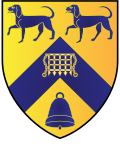Portal:University of Oxford
| Main page | Indices | Projects |
The University of Oxford portal
The University of Oxford is a collegiate research university in Oxford, England. There is evidence of teaching as early as 1096, making it the oldest university in the English-speaking world and the world's second-oldest university in continuous operation. It grew rapidly from 1167, when Henry II banned English students from attending the University of Paris. After disputes between students and Oxford townsfolk in 1209, some academics fled north-east to Cambridge where they established what became the University of Cambridge. The two English ancient universities share many common features and are jointly referred to as Oxbridge.
The University of Oxford is made up of thirty-nine semi-autonomous constituent colleges, four permanent private halls, and a range of academic departments which are organised into four divisions. Each college is a self-governing institution within the university, controlling its own membership and having its own internal structure and activities. All students are members of a college.
It does not have a main campus, but its buildings and facilities are scattered throughout the city centre. Undergraduate teaching at Oxford consists of lectures, small-group tutorials at the colleges and halls, seminars, laboratory work and occasionally further tutorials provided by the central university faculties and departments. Postgraduate teaching is provided in a predominantly centralised fashion.
Oxford operates the Ashmolean Museum, the world's oldest university museum; Oxford University Press, the largest university press in the world; and the largest academic library system nationwide. In the fiscal year ending 31 July 2023, the university had a total consolidated income of £2.92 billion, of which £789 million was from research grants and contracts.
Oxford has educated a wide range of notable alumni, including 30 prime ministers of the United Kingdom and many heads of state and government around the world. 73 Nobel Prize laureates, 4 Fields Medalists, and 6 Turing Award winners have matriculated, worked, or held visiting fellowships at the University of Oxford, while its alumni have won 160 Olympic medals. Oxford is the home of numerous scholarships, including the Rhodes Scholarship, one of the oldest international graduate scholarship programmes. (Full article...)
Selected article
The Bodleian Library is the main research library of the University of Oxford. It is one of the oldest libraries in Europe, and in Britain is second in size only to the British Library. Known to Oxford scholars as "Bodley" or simply "the Bod", it is one of six legal deposit libraries under the Legal Deposit Libraries Act 2003 for works published in the United Kingdom and under Irish Law it is entitled to request a copy of each book published in the Republic of Ireland. Though University members may borrow some books from dependent libraries (such as the Radcliffe Science Library), the Bodleian operates principally as a reference library and in general documents cannot be removed from the reading rooms. The Bodleian was established in 1602 by Thomas Bodley, who donated some of his own books. The library has expanded considerably since its foundation, and now houses 8 million items on 117 miles (188 km) of shelving. The buildings on the main site include Duke Humphrey's Library (completed 1488), the Radcliffe Camera, the Clarendon Building and the New Bodleian (designed by Sir Giles Gilbert Scott and completed in 1940). (Full article...)
Selected biography
Selected college or hall
Lady Margaret Hall (generally known as "LMH") was established in 1878 and was the first college for women at the university. It began to admit men as students in 1979, and was the first of the women's colleges (along with St Anne's) to become a mixed-sex institution. The college, set in spacious grounds in Norham Gardens to the north of the city centre, is named after Lady Margaret Beaufort, mother of King Henry VII and a renowned patron of learning. Its first principal was Elizabeth Wordsworth, the great-niece of the poet William Wordsworth. Giles Gilbert Scott, famous for designing Liverpool Cathedral and the K2 red telephone box, designed the college's Byzantine-style chapel. There are approximately 600 undergraduate and postgraduate students; former students include the former prime minister of Pakistan Benazir Bhutto, the writer Antonia Fraser, the former director general of MI5 Eliza Manningham-Buller, and the actor Samuel West. LMH's motto is "Souvent me Souviens", an Old French phrase meaning "I remember often". (Full article...)
Selected image

Did you know
Articles from Wikipedia's "Did You Know" archives about the university and people associated with it:
- ... that John Prideaux Lightfoot commissioned the Adoration of the Magi tapestry (detail pictured) from Morris & Co. for the Gothic revival chapel at Exeter College, but died before it was completed?
- ... that special trains were laid on for voters returning to Oxford for the 1860 election of the Boden Professor of Sanskrit?
- ... that William Morfill was the first professor of Russian in Britain?
- ...that a scathing obituary of British author Lord Michael Pratt in The Daily Telegraph called him "an unabashed snob and social interloper on a grand scale", who habitually outstayed his welcome?
- ... that one 16th-century Registrar of the University of Oxford was dismissed after neglecting his duties for a year, then imprisoned and fined after throwing a punch when the debate had ended?
Selected quotation
Selected panorama
Wikimedia
The following Wikimedia Foundation sister projects provide more on this subject:
-
Commons
Free media repository -
Wikibooks
Free textbooks and manuals -
Wikidata
Free knowledge base -
Wikinews
Free-content news -
Wikiquote
Collection of quotations -
Wikisource
Free-content library -
Wikiversity
Free learning tools -
Wikivoyage
Free travel guide -
Wiktionary
Dictionary and thesaurus















